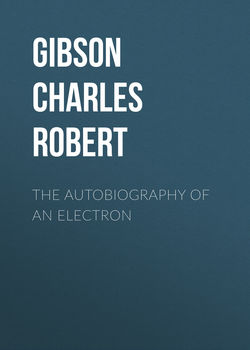Читать книгу The Autobiography of an Electron - Gibson Charles Robert - Страница 2
CHAPTER I
WHAT THE STORY IS ABOUT
ОглавлениеThe reason for writing this story is given in the Preface, but the title is so strange that the reader will wish naturally to know what the story is about. What is an electron? Is it an imaginary thing, or is it a reality?
One of the reasons for writing this story in its present form is to help the reader to realise that electrons are not mythical, but real existing things, and by far the most interesting things we know anything about. The discovery of electrons has shed a new light upon the meaning of very many things which have been puzzles until now. They give us a reasonable explanation of the cause of light and colour. They provide a new idea of the constitution of matter. They enable us to picture an electric current, and they give us definite, though by no means final, answers to the why and wherefore of magnetism, chemical union, and radio-activity.
The story is imaginary only in so far that one of the electrons itself is supposed to tell the tale. But in the endeavour to make the story interesting, there has been no sacrifice of accuracy in the statements of fact.
While all names and dates, and many other details, have been kept out rigidly from the story, a note of the more important of these has been added in an Appendix for the sake of those readers who may wish to refer to them.
It will be well to introduce the electron to the reader before leaving it to speak for itself. We have definite experimental proof of the existence of electrons, and yet it is very difficult to realise their existence, for two reasons. In the first place, they are so infinitesimally small. We count a microbe a small thing; we can see it only with the aid of a very powerful microscope. Yet that little speck of matter contains myriads of particles or atoms. An atom of matter is therefore an inconceivably little thing, but even that is a great giant compared to an electron. Our second difficulty in realising the existence of an electron is that it is not any form of what we call matter; it is a particle of electricity, whatever that may be.
From the earliest experiments it became evident that there were two distinct kinds of electricity. These were described by the pioneer workers as positive and negative electricities. To-day we have definite experimental proof that negative electricity is composed of separate particles or units. Just as matter is composed of invisible atoms, so also is negative electricity of an atomic nature. These particles of negative electricity have been christened electrons, electron being the Greek word for amber, from which man first obtained electricity. Of course no one can ever hope to see an electron, but physicists have been able to determine its size and mass, its electric charge, and the speeds at which it moves.
While it has been known for more than a century that light is merely waves in the all-pervading æther of space, set up by incandescent bodies, it has been a puzzle always how matter could cause waves in the æther, as it offers no resistance to the movement of matter through it. Here we are on the back of a great planet, flying through space at the enormous rate of one thousand miles per minute, and yet our flimsy atmospheric blanket is in no way disturbed by the æther through which we are flying. In the following story we shall see that these electrons help us towards a solution of this and many other problems; they provide the missing link between matter and the æther.
But what is this æther of which one hears so much in these days? The truth is we know nothing of its nature. We cannot say whether it is lighter than the lightest gas or denser than the densest solid. The æther, whatever it may be, is as real as the air we breathe. It is the medium which brings us light and heat from the sun, and which carries our wireless telegraph and telephone messages. The whole universe is moving in this great æther ocean.
In order to make the electron's story perfectly intelligible to every reader, I have added a short explanatory note at the beginning of each chapter. These notes merely state the facts about which the electron is speaking.
To make the electron's story as realistic as possible, it has been necessary to give the imaginary electron perfect freedom of knowledge concerning itself and its surroundings. In our schooldays we had to write the autobiographies of steel pens, and such-like, but these inanimate things had to be endowed with powers of thought, feeling, and desire. It is very important, however, to remember that an electron is a particle of negative electricity —a real existing thing.
